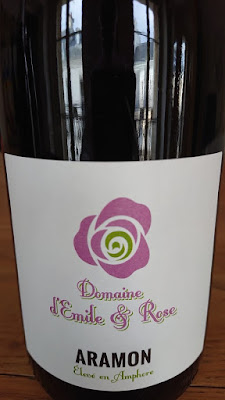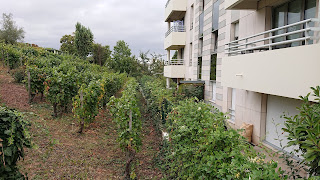It takes longer to go by train from London to Leeds or Manchester than to Paris so why not go to Paris? This we do whenever we can. Do we have to give reasons?
All right, here are some excuses. You know how one is always on the lookout for a good Aligote? We have tried all over the place (Bourgogne, Ukraine, California) but apart from one (by Au Bon Climat?) a very long time ago they have been steely to the point of meanness, watery to the point of tasteless or just over-oaked. Now, on our most recent trip to Paris, here was the perfect Aligote and we weren't even looking for it. No, we were invited to Le Bistrot de Paris and being habitues, our friends had discovered this Aligote by Domaine Dubois of Premeaux-Prissey, close to Nuits Saint Georges which they always order when there.
It is a real find (not widely available). It comes in at a very modest price under E.10.
Yes, it's the Pont Louis-Philippe again and that can only mean another visit to our favourite Paris wineshop, L'Etiquette.
Chez Herve at L'Etiquette we grabbed this bottle of Aramon having had Aramon Gris believe it or not (Paul Reder's wonderful 'Gri-gri') but never the more common red Aramon as a monocepage. This is remarkable as Aramon used to be widely planted thanks to its great productivity and resistance to powdery mildew but there are now only about 3,000 ha., down from 150,000 in 1958. 'Wine Grapes' has it that Aramon was 'once responsible for some of France's least noble wine.' We can't wait to try it.
 |
| belle robe. |
 |
| Plantet |
 |
| Pineau D'Aunis |
 |
| 'Gamay Blanc' |
Although we could stay in L'Etiquette all day we decided on this trip to take a look at some other cavistes. The first was Les Babines, near the Place de la Republique.
Here we played our usual game of 'hunt the cepage rare.' It's a fun thing to do especially in France where as you know, it is against the law to mention the grape variety on the label in many cases. We would like to know more about why this is so and since when it has been the case. Meanwhile, after some head scratching our guide put his hand on something truly rare: a bottle of Bouysselet.
'Wine Grapes' mentions Bouyssales as a synonym for Cot in Tarn-et-Garonne but Bouysselet is a white grape from Villaudric near Fronton in the case of this bottle and has no entry in that august volume. Galet gives it an entry naming Prunelard Blanc as a synonym at Fronton. Bouysselet is being brought back from extinction by the Chateau La Colombiere. Honour to them!
Acting on a tip-off we were just making our way along the rue Jean-Pierre Timbaud when this establishment hoved into view. We had a quick scout around and saw that they had all the right vins naturels you could want. Definitely somewhere to check out another time. They were pleasant too.
 |
| note the old cashiers' booth (right) and the hand cheese display. |
 |
| Restaurant space at the back. |
Galet lists a Rousselon Blanc as being the name for Saint Pierre dore in the Aveyron which is probably what we have here. Saint Pierre Dore is not commercially cultivated according to 'Wine Grapes' which mentions it in its capacity as yet another offspring of Gouais Blanc.
 |
| Philippe Rousseau (right) |
 |
| Roussellou grapes |
Vinum Picatum in the Rue Letort (18ieme) was our last tip-off. A well-established shop with once again, a good selection including some bottles of Louis-Antoine Luyt wines from Chile.
Our guide on this occasion was not very keen to play our 'cepage rare' game and gave us to understand that he didn't regard this as the right way to go about buying a bottle of wine. He may be right but after explaining we were collectors of rare grape varieties he gave the exercise his attention and finally put his hand on something just as rare as Bouysselet and Roussellou - Damas Noir. A Hat Trick!
Galet has an entry on Damas Rouge which seems to be from Puy-le-Dome which indeed is the provenance of this Damas Noir according to the back label. However, Galet goes on to say 'On ne peut le confondre ni avec le Damas Noir du Puy-le-Dome qui est le Syrah, presente dans l'ancien vignoble de Riom (Levadoux) ni avec la Mondeuse (Guyot), et encore moins avec le Mourvedre (Rovasenda).' We're not quite sure where this leaves us but the back label does mention 'Petite Syrah Auvergnate' as a synonym for what we have here.
We think it is safe to assume this Damas Noir is not Syrah but more likely what Galet refers to as Damas Rouge.
Damas Rouge gets a mention in 'Wine Grapes' as a synonym for Noir Fleurien - also from Puy-le-Dome. This Noir Fleurien is almost extinct, appearing in a blend by Jean Maupertuis and in what is termed 'domestic consumption.'
That's a real story behind the label if one that needs further enquiry.
For our final adventure we decided to visit the Paris vineyard of Suresnes. In the Middle Ages, most of the wine consumed in Paris was grown locally in the Ile de France. Indeed there is a move to revive some of those vineyards. Meanwhile the best known Paris vineyard at Montmartre, although ancient produces only overpriced wine for the tourist market.
There are one or two other much smaller vineyards in Paris but Suresnes is a proper little vignoble growing Chardonnay and Sauvignon Blanc.
Suresnes is just over the bridge from the Bois de Boulogne, not far from Puteaux where the great composer Vincenzo Bellini died. It is a prosperous leafy suburb but if you want to buy the wine (at E.11 - 13 - half the price of Montmartre wine) you have to go to the Office de Tourisme.
There they sell some other produce from Suresnes such as honey. The nice people there will give you a map and directions to the vineyard which is an uphill walk of about 15' from there.
 |
| the label mentions only Chardonnay but Sauvignon Blanc is there too |
the vineyard is close by apartment buildings and overlooked by pleasant villas. Apparently it disappeared in mid 20th century and has been revived since by the municipality and volunteers.
 |
| Can you see the Tour d'Eiffel on the horizon? |
Some of the grapes looked good
a few were suffering from mildew.
On Mondays you can visit the vineyard and have a vineyard tour.
There is a convenient tram near the bottom of the hill that takes you to La Defence. A better way of getting there than taking the bus through the Bois de Boulogne from Ports Maillot.
On the way home we saw a bizarre poster for Haussmann wines (Bordeaux). We wondered what was going on. The mature lady on the right has a glass of wine in her hand. The younger one on the lsft hasn't. What could the message be?
There is another Tannat/Cabernet Sauvignon cross from the same provenance called Arinarnoa which we have noted previously. If grape breeders want their vines to catch on, maybe they should give Basque names a rest?
Just a few doors down from Le repere de Bacchus is another even more 'normal' wine shop, Nysa. Also part of a chain we were surprised to find this Cinsault/Muscat blend on prominent display in front of the cash desk. Another cryptic label: 'Bu End' was a strange marketing choice. The wine was also strange for those unfamiliar with Muscat as a (30%) component of Red wine. The producer, J.M. Rimbert doesn't say what kind of Muscat he is using but since he talks about making the wine from left-over grapes, we assume this was a white Muscat rather than Muscat Noir or Bleu. We adore this kind of beverage and have two bottles of Red Muscat in our collection already. It is somewhet sweet as you may imagine but irresistable.
There we were. It seems in Paris you can't walk along the street without stumbling over something interesting and we're not talikng about dog mess this time.

































No comments:
Post a Comment